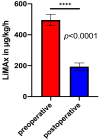Perioperative LiMAx Test Analysis: Impact of Portal Vein Embolisation, Chemotherapy and Major Liver Resection
- PMID: 38397856
- PMCID: PMC10886999
- DOI: 10.3390/biomedicines12020254
Perioperative LiMAx Test Analysis: Impact of Portal Vein Embolisation, Chemotherapy and Major Liver Resection
Abstract
Background: Postoperative liver failure (PLF) is a severe complication after major liver resection (MLR). To increase the safety of patients, clinical bedside tests are of great importance. However, limitations of their applicability and validity impair their value.
Methods: Preoperative measurements of the liver maximum capacity (LiMAx) were performed in n = 40 patients, who underwent MLR (≥3 segments). Matched postoperative LiMAx was measured in n = 21 patients. Liver function was compared between pretreated patients (n = 11 with portal vein embolisation (PVE) and n = 19 patients with preoperative chemotherapy) and therapy naïve patients. The LiMAx values were compared with liver-specific blood parameters and volumetric analysis.
Results: In total, n = 40 patients were enrolled in this study. The majority of patients (n = 33; 82.5%) had high preoperative LiMAx values (>315 µg/kg/h), while only seven patients (17.5%) had medium values (140-315 µg/kg/h), and none of the patients had low values (<140 µg/kg/h). A comparison of pretreated patients (with PVE and/or chemotherapy) and therapy naïve patients showed no significant difference in the preoperative LiMAx values (p > 0.05). The preoperative LiMAx values were significantly higher than the matched postoperative values on postoperative day 1 (p < 0.0001). A comparison between the expected and measured postoperative LiMAx showed a difference (≥10%) in 7 out of 13 patients (53.8%). After an initial postoperative decrease in the LiMAx, the patients without complications (n = 12) showed a continuous increase until 14 days after surgery. In the patients with postoperative complications, a decrease in the LiMAx was associated with a prolonged recovery.
Conclusions: For patients undergoing MLR within the 0.5% rule, which is the clinical gold standard, the LiMAx values do not offer any additional information. Additionally, the LiMAx may have reflected liver function, but it did not deliver additional information regarding postoperative liver recovery. The clinical use of LiMAx might be relevant in selected patients beyond the 0.5% rule.
Keywords: LiMAx test; liver function test; major liver resection; perioperative risk assessment; portal vein embolisation; postoperative liver failure.
Conflict of interest statement
The authors declare no conflicts of interest.
Figures




References
-
- Jarnagin W.R., Gonen M., Fong Y., DeMatteo R.P., Ben-Porat L., Little S., Corvera C., Weber S., Blumgart L.H. Improvement in perioperative outcome after hepatic resection: Analysis of 1803 consecutive cases over the past decade. An. Surg. 2002;236:397–406. doi: 10.1097/00000658-200210000-00001. - DOI - PMC - PubMed
-
- Rahbari N.N., Garden O.J., Padbury R., Brooke-Smith M., Crawford M., Adam R., Koch M., Makuuchi M., Dematteo R.P., Christophi C., et al. Posthepatectomy liver failure: A definition and grading by the International Study Group of Liver Surgery (ISGLS) Surgery. 2011;149:713–724. doi: 10.1016/j.surg.2010.10.001. - DOI - PubMed
LinkOut - more resources
Full Text Sources

